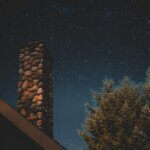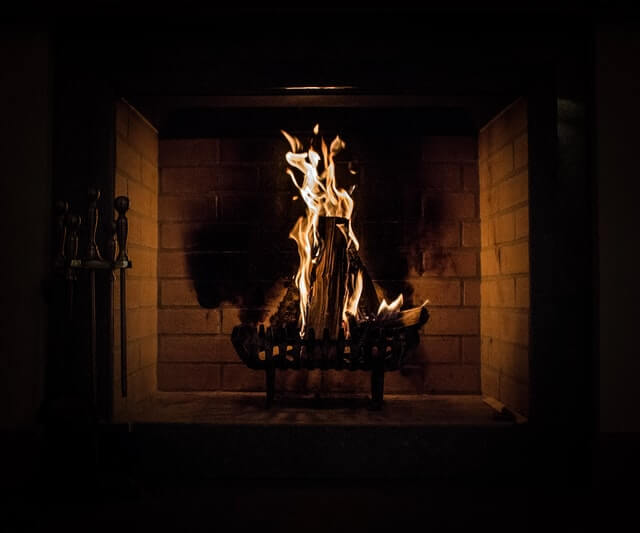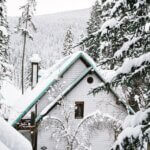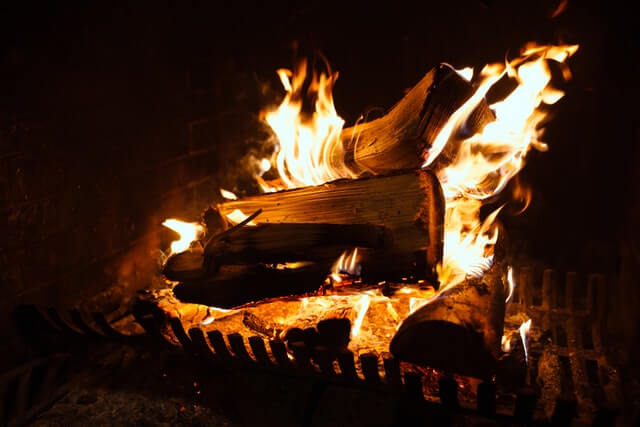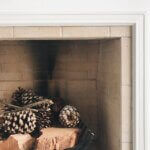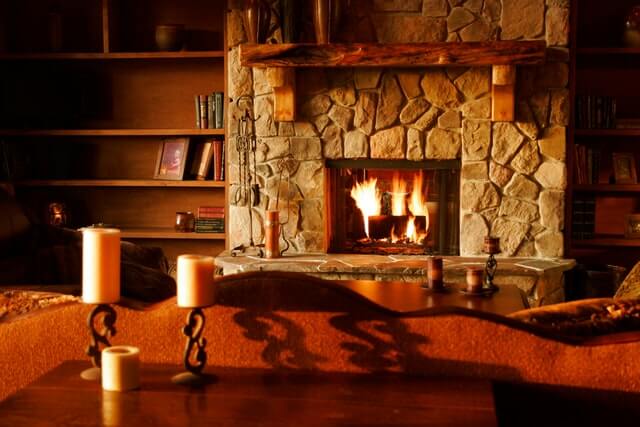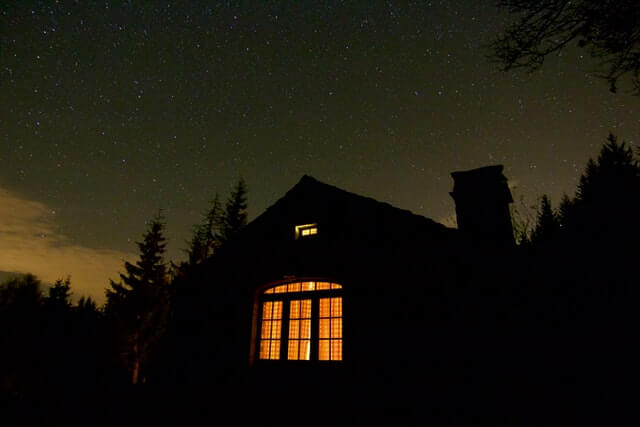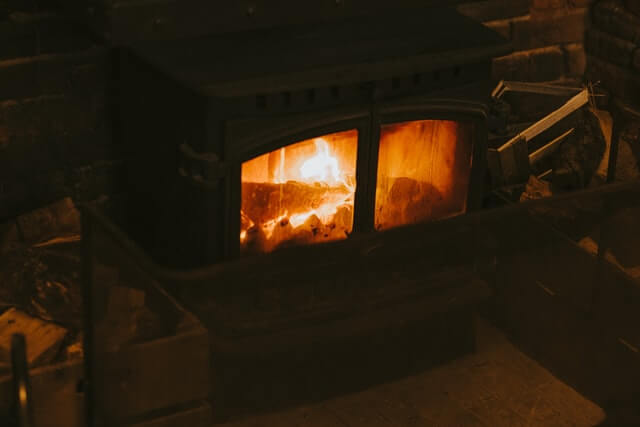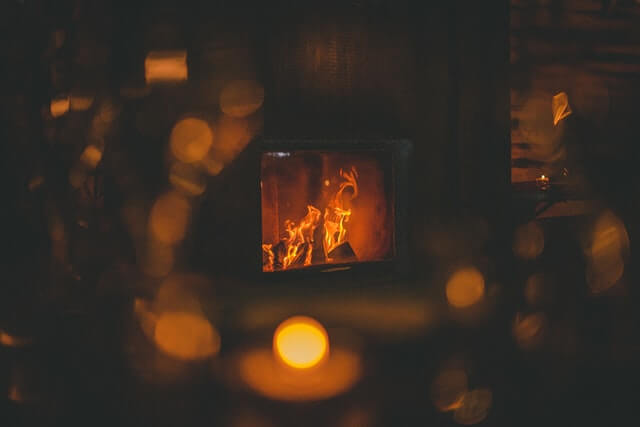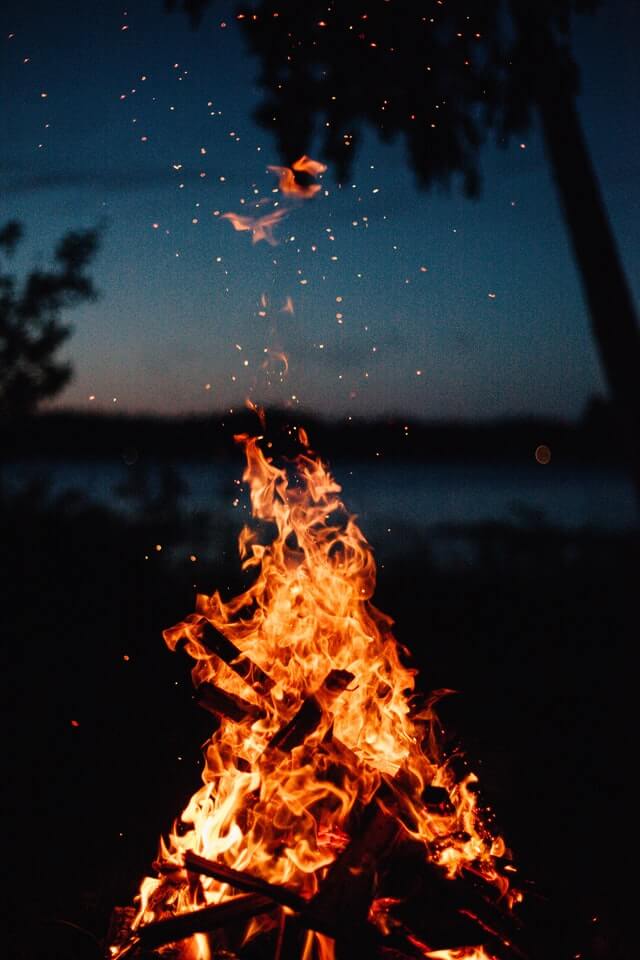Is a Damper and a Fireplace Flue the Same Thing?
Is a damper and a fireplace flue the same thing? Having a fireplace is incredibly beneficial for the cold Indiana winters, but it also comes with a big responsibility. To keep your fireplace working and safe, you must perform the proper fireplace and chimney maintenance. Keeping track of all the different parts of your fireplace can get confusing for the typical Indianapolis homeowner.
Two of the key parts to understand are the damper and flue. These two terms often get mixed up, even though they are not synonymous. However, they are both involved in a certain function of your fireplace.
Read on to learn everything you need to know about the fireplace damper and flue.
What’s a Flue?
The flue is a pipe or tube that brings smoke from your fireplace out of your home. The smoke from your chimney is drawn out of your house via the chimney flue. If you did not have a flue, the smoke and gases would stay in your home and pose a serious hazard.
All wood-burning fireplaces have a chimney flue. The flue can be a simple pipe or a duct, but it must be the right size for your capacity of your fire system. To protect your flue, you should have a flue liner. The flue liner helps shield the flue from the toxic gases and extreme heat it is exposed to.
What’s a Damper?
The flue damper is inside the flue. The primary function of the damper is to regulate the airflow of the flue. To ensure the flue can carry the hazardous gases out of your home, you’ll need the damper to be open.
How the Damper and Flue are Related
The damper and flue are two different parts, but they are related and involved in the same function. The flue is the inside tunnel of your chimney that brings gases from your fireplace out of your home, while the damper closes or opens the access to the flue.
When to Open or Close Your Damper
While the damper is necessary for the flue to do its job, the damper should not always be open. Before lighting a fire or using the fireplace, you should fully open the damper. Keep the damper fully open until all of the embers in your fireplace are done burning.
Some people believe that partially closing the damper while using the fireplace may preserve heat, but that’s not the case. Instead, a partially or fully closed damper will lock the passage to the flue, which will cause smoke to enter your home.
When you are not using the fireplace, close the damper to prevent a draft and keep the controlled air inside your home from escaping. An open damper works like a window and can allow heat to escape your home. To ensure you keep the heat in your home, close the damper when your fireplace is not in use.
Signs of a Broken Damper
A broken damper will not allow your flue to have proper airflow, and it will need to be addressed quickly. Excessive heat or smoke in your home while using your fireplace are signs of a damper that’s not functioning correctly. Damaged dampers pose a smoke and carbon monoxide hazard and must be handled as soon as possible.
Damper and Flue Services
To keep your fireplace and chimney working correctly and safely, you must regularly clean and inspect it. A chimney sweep and inspection is a small investment that can save you a lot of time and money down the line. An experienced chimney sweep will be able to quickly identify any issues with your chimney flue or damper, so that you can resolve any minor issues before they become more severe down the line.
Whether you have more questions about fireplace parts like the damper or flue, or you need maintenance and repair, your dedicated Brick + Ember Outfitters of Indianapolis are here to help. Our knowledgeable experts can help with all of your fireplace and chimney needs. We offer affordable, high-quality chimney sweeps and inspection, as well as all the services you need to take care of your fireplace. We’re happy to answer any questions you may have and explain how our services can help you optimize your fireplace for years to come. To learn more about our fireplace and chimney services or to schedule your appointment, contact Brick + Ember Outfitters Indianapolis today at 1-317-500-1250 or OFFICE@BRICKANDEMBER.COM.
How Long Should a Chimney Crown Last?
How long should a chimney crown last? Many Indianapolis homes have a sought-after fireplace and chimney. Chimneys are their own small structures, and they can add an appealing visual element to the outside of your home. Keeping your chimney strong and beautiful for many years is important for the value of your home. Understandably, many homeowners do not know the ins and outs of their chimney. As a Indianapolis homeowner, it’s important to know the basic components of your chimney and how long they each last.
How Often Should You Schedule A Chimney Inspection?
How often should you schedule a chimney inspection? The answer is somewhat complicated. It depends on a couple of factors. First, there are guidelines from the National Fire Protection Association that everyone should follow. But second, it depends on how often you use your fireplace, and how much creosote buildup you have in your chimney. Let’s look at these factors in greater detail.
The National Fire Protection Association Standard 211 says that chimneys should be inspected at least yearly to check for soundness, creosote deposits, and the right clearances. Cleaning, maintenance, and repair should occur if needed. This holds true even if you don’t use your chimney frequently because your chimney may have obstructions you don’t know about, such as a bird’s nest, which would be dangerous if you light a fire.
The Chimney Safety Institute of America (CSIA) says an open masonry chimney should be swept at ⅛” of sooty buildup--sooner if there’s any glaze in the chimney. Metal fireplaces should be swept after any sooty buildup because of the buildup’s acidic properties. This is meant to extend the life of the chimney.
Statistics indicate that around 25,000 chimney fires occur in the US annually, many of which could have been prevented if not for creosote buildup.
What is Creosote?
Creosote is a byproduct of wood combustion composed primarily of tar. Wood fires will always produce a certain amount of creosote. Creosote eventually hardens and sticks to the inside of your chimney. While small amounts of creosote aren’t worrisome, a buildup of creosote in your fireplace can be harmful. Creosote goes through three stages: first, second, and third degree.
First Degree Creosote
First degree creosote has a high percentage of soot and can be cleaned easily with a chimney brush. First degree creosote means there’s good combustion of wood and high flue gas temperatures. The fire has plenty of oxygen and the heat passes up quickly through the chimney. This is the ideal situation for your chimney.
Second Degree Creosote
Second degree creosote is flaky and tar-like, and more difficult to remove. It occurs when air is more restricted. You often see second degree creosote in wood stoves and fireplaces with glass doors.
Third Degree Creosote
When flue temperatures are low or combustion is incomplete, you get third degree creosote. Third degree creosote looks like tar coating, can drip like wax inside the chimney, and is the most difficult to remove.
Why is Creosote Dangerous?
Creosote is highly flammable and can cause an explosion if you build a fire and the creosote in your chimney ignites. Far more frequent than explosions are less flamboyant chimney fires, which can damage your chimney, destroy your home and even kill you.
Another reason you should try to prevent creosote from building up in your chimney is that it can cause carbon monoxide poisoning. If the inside of your chimney is caked with creosote, the carbon monoxide from the fire cannot escape out of the chimney as it typically would and instead flows into your house. Carbon monoxide poisoning is deadly.
Creosote is carcinogenic. Studies by the Agency for Toxic Substances and Disease Registry indicate that people exposed to creosote regularly are more prone to cancer than people not exposed to creosote.
How Can You Limit Creosote Buildup in Your Chimney?
Use Kiln-Dried Firewood
Kiln-dried firewood is more effective than air-dried firewood at preventing creosote buildup because it’s dried in a kiln, which dries the wood faster than air-drying. Air-dried wood has a moisture content of 25%, and kiln-dried wood has a moisture content of 10%. With a lower moisture content, kiln-dried firewood burns cleaner than air-dried firewood, which results in less creosote.
Open the Damper All the Way
Some people think opening the damper only partially while burning a fire will keep in the heat better, but it actually reduces the heat, because not enough oxygen is getting to the fire, making the fire weaker than it could be. With the damper only partly open, your fire won’t get as hot. The lower heat will create more creosote. If your damper is stuck closed, do not light fires until you have it repaired or replaced.
Don’t Smother the Fire
Arrange your firewood so that it can breathe. Leave some space for it to oxygenate, otherwise your fire won’t get enough oxygen, and it will make more creosote as a byproduct.
Continue to Have Your Chimney Inspected Annually
Regardless of whether or not you follow these tips, you should still have your chimney inspected at least annually. A chimney inspection will be able to tell you how much creosote has built up in your chimney, and whether you need your chimney cleaned. They will also tell you if there are any problems with your chimney or fireplace, or if anything needs repair or replacement.
Chimney Services in Indianapolis
As a general guideline, have your chimney inspected at least once a year--more if you experience problems with your chimney or fireplace. There are ways to minimize creosote buildup, but you still need the annual inspection for your own and your loved ones’ safety. A chimney sweep can tell you how much creosote has built up in your chimney.
Call Brick + Ember Outfitters of Indianapolis for your annual inspection. Our CSIA-certified staff are well-equipped to address all of your fireplace and chimney-related needs. Have creosote buildup? Don’t hesitate, call us today, or make an appointment from our website.
How Do I Start My Fireplace For the First Time?
How do I start my fireplace for the first time? You might think starting a fire in your fireplace for the first time will be easy. When they think of a fireplace, most people imagine relaxing placidly by an already perfectly formed, lovely fire. They don’t think about the preparation behind the fire. There are actually several preliminary steps and precautions to take before you even light a fire. Here is a definitive list of steps to take when lighting your first fire.
Install Detectors and an Extinguisher
Before you start your fireplace for the first time, install a smoke detector and carbon monoxide detector to let you know if too much smoke is building up or if carbon monoxide is present. Also, install a fire extinguisher near the fireplace.
Check for Blockage
Next, make sure nothing is blocking the chimney, such as debris or a bird’s nest. Otherwise, since the chimney is meant to vent smoke out of the home, the smoke will have nowhere to go but inside the house. Also, make sure there is a flue cover at the top of the chimney to prevent sparks from causing an exterior roof or building fire.
Make sure the chimney has been swept for creosote and soot buildup, which can cause a chimney fire. You should have your chimney and fireplace inspected annually.
Use a Screen
Get a screen or a metal fireplace curtain and put it in front of the fire to prevent sparks from flying onto furniture or carpeting. The screen should cover the entire front of the fireplace. Keep pets and children away from the fire.
Kindling
Put small sticks, pieces of wood, and some crumpled up newspaper on top of the internal fireplace grate. You can also put crumpled newspaper below the grate. Stack wood logs horizontally on top of the kindling in a criss-cross pattern, leaving some openings for airflow. Add some more small sticks to the wood.
Open the Damper
Open the damper, located inside the chimney at the fireplace end. Generally, you pull it down to open it and push it up to close it. The damper should always be open when the fireplace is in use. You can close it when it’s not in use to lessen drafty air coming through the chimney from outside.
Light the Fire
Using a long-handled lighter or matches, ignite the newspaper and kindling. Stir the sticks around with a fireplace poker until the logs ignite.
Never leave a fire unattended. Make sure the fire is completely out if you leave the house or go to bed.
Avoid Chimney Fires
Keep your chimney clean to protect it from chimney fires. Chimney fires are a big deal; they can even be deadly. And they may not be obvious. While some chimney fires are loud and dramatic, most go unnoticed until inspection time.
Some chimney fire indicators include a popping sound coming from the chimney, abundant smoke, or a hot smell coming from the chimney. Some chimney fires are as noisy as a train or low-flying plane. However, the majority are unrecognized.
A slow-burning chimney fire can do as much damage and be as great of a threat to your chimney and even your home as a noisy fire.
Creosote
Chimneys exhaust the byproducts of combustion: water vapor, smoke, gases, unburned wood particles, tar fog, hydrocarbon, and assorted minerals pass from the fireplace through the cooler chimney, creating condensation. The sticky residue left on the inside of the chimney is called creosote.
Creosote is highly combustible, and if there’s enough creosote buildup in your chimney, it can make for a dangerous situation. Certain conditions cause creosote to build up, including low air supply, unseasoned wood, and cooler than usual chimney temperatures. You may inadvertently restrict air supply by closing the glass doors or not opening the damper wide enough.
Masonry Chimneys
When a chimney fire occurs in a masonry chimney, the high temperature (2,000 degrees) can collapse liners, melt mortar, crack tiles and damage outer masonry. Frequently, thermal shock occurs, displaces mortar and cracks tiles, and opens a pathway for the fire to reach the house’s wood frame. If this happens, you should call 911 right away.
Prefabricated Chimneys
Prefabricated metal chimneys are built to withstand temperatures up to 2100 degrees without sustaining damage. However, in a chimney fire, damage can still occur. If they do get damaged by a chimney fire, they should be replaced.
Wood Stoves
Wood stoves can withstand hot temperatures but the connector pipes that run from the stove to the chimney cannot. In a chimney fire, these pipes can warp and buckle, and if this happens, they would need to be replaced.
Signs That You’ve Had a Chimney Fire
A CSIA-certified chimney sweep will look for these signs of a chimney fire in and around your chimney:
- Puffy creosote
- Creosote flakes on the floor or ground
- Warped damper metal or connector pipe metal
- Cracked, broken, or collapsed flue tiles
- Damaged roofing material from hot creosote
- Discolored or warped rain cap
- Cracks in exterior masonry
- Smoke escaping through masonry mortar joints or tile liners
- Heat-damaged TV antenna on the chimney
If you think you’ve had a chimney fire, call a CSIA-certified chimney sweep immediately. A CSIA-certified chimney sweep will inspect your chimney for signs of fire, damage incurred and make recommendations about how to repair the chimney. In some cases, you may have to replace a chimney that’s experienced a chimney fire.
At Brick + Ember Outfitters of Indianapolis, we are CSIA (Chimney Safety Institute of America) certified. If you have concerns about your fireplace or chimney, don’t hesitate. We offer comprehensive fireplace and chimney services to help you with all of your maintenance and repair needs. Give us a call at 317-500-1250 or make an appointment on our website today.
The Most Popular Fireplace Design
The most popular fireplace design? A fireplace is a beautiful addition to your home. Great for social gatherings and priceless for family time, there’s nothing more intimate and welcoming than the warmth of a fire. If you don’t already have a fireplace, choosing one can be a bit overwhelming. That’s understandable. It’s a sizable investment, so you want to be certain you’ve chosen the right fireplace for your needs. But how do you do that?
Let’s look first at the different fuel types of fireplaces. Then, we’ll explore design. By the end of this article, you should have a better idea of what you’re looking for, and if not, you can always talk to an expert.
Fuel Types
There are three common types of fireplaces: wood-burning, gas, and electric. Each has its own benefits and limitations. While cost is outlined here, your best bet is to get a quote from a professional.
Wood-burning
Wood-burning fireplaces are the most traditional. If you want to warm yourself in front of a roaring, crackling fire, you may be interested in a wood-burning fireplace. A wood fireplace will give you an additional heat source without relying on gas or electricity. You will, however, have to chop or have access to firewood.
Wood-burning fireplaces are the most expensive to install and require the most maintenance. There’s ash to clean up inside the firebox and creosote buildup in the chimney. You will need an annual chimney sweep and inspection to ensure that everything is running smoothly and all parts of the chimney and fireplace are intact.
According to homeguide.com, it costs $1900 to $3300 to install a wood fireplace. If you want a masonry fireplace installed, it will cost $3500-$5600.
Gas
Gas fireplaces are increasing in popularity because of their ease of use. There’s no need for firewood or keeping the fire going; you can activate and deactivate it with the flip of a switch. Some are even remote-operated.
There’s no ash to clean up with a gas fireplace, and they’re cleaner for the environment. Ceramic logs closely resemble the real thing, so you’re not sacrificing the look and feel of a wood fireplace.
Gas fireplaces don’t produce smoke, sparks, or embers, making them safer than wood fireplaces, especially if you have pets or young children.
To run a gas fireplace, you will have to have a gas line installed. You will need an annual inspection to make sure everything is in working order.
It costs $2,280 to $4,030 to install a gas fireplace. If you opt for a vent-free fireplace, it will cost about $1,200 less. If you don’t have a gas line, installation may cost more, unless you can find an installation company who will install it for free because they want your business.
Electric
Electric fireplaces are excellent for small homes and apartments. You can move them to a new home with you, or even just from room to room. Like gas fireplaces, they are easy to use and don’t require a chimney. Some electric fireplaces are built into furniture, such as television consoles.
Electric fireplaces only need an outlet to function. They’re safer than wood-burning fireplaces and more effective at warming up a room because the heat doesn’t escape up a chimney. Further, you can run them without the heat so that you can enjoy them year-round.
Electric fireplaces cost $100 to $2,200 or higher. Installation labor costs $0 to $365, but you’ll only have labor costs if you need a new outlet installed or if the fireplace needs to be attached to a wall.
Design Ideas
There are three popular types of fireplace design: traditional, contemporary, and modern. Which design you should choose depends on your personal preferences and the design of your home.
Traditional
Traditional fireplaces are built from brick or stone. Wood-burning fireplaces often have the traditional-style. These fireplaces evoke a sense of rustic beauty and cozy charm. Traditional fireplaces look best in cottages, log cabins, and older homes.
Contemporary
Contemporary fireplaces are also frequently made from brick or stone, but lines are sharp and well-defined. Contemporary-style fireplaces are best suited to similarly contemporary homes.
Modern
Modern fireplaces have a futuristic look to them. Rather than brick or stone, they are often composed of materials like marble or glass. Modern fireplaces are, predictably, well-suited to modern homes.
What Should I Choose?
Let Fire Mercantile help you with design ideas for your fireplace. A company developed by Brick + Ember Outfitters, Fire Mercantile exists to help customers reimagine their fireplaces.
Fire Mercantile has a simple, four-step process. First, you meet with a hearth design specialist who will discuss the latest design trends with you and help figure out what meets your needs in terms of budget, personal preferences, and what will best fit your home. Next, your specialist will help you choose your custom fireplace design. Then, it’s time to schedule your installation. Finally, you get to enjoy your new fireplace.
For all of your fireplace needs, call Brick + Ember Outfitters at 317-500-1250. Our design team can’t wait to work with you. Give us a call or make an appointment right from our website.
How Much Does it Cost to Repair a Chimney?
Having a fireplace adds charm and value to your Indianapolis home, and fireplaces are a highly sought after feature in modern homes. However, they do take work. As a homeowner or prospective buyer, it’s understandable to be concerned about how much it would cost to refurbish an old fireplace or chimney. In today’s post, we’ll break down everything you need to know about the cost of chimney repair.
The Average Cost
Every chimney refurbish is unique, and depends on the specific condition yours is in. Because of that, there’s quite a large range for the potential cost of refurbishing a fireplace/chimney. According to Home Advisor, it costs an average of $1,000 to $3,000 to rebuild a chimney.Larger chimneys with more bricks can cost $5,000 or more.
Rebuilding a chimney stack costs $150 per linear foot. Sometimes a chimney only needs a partial rebuild, but other times it will require a complete overhaul, which will cost $1000 to $1600.
Replacing a chimney is much more expensive, starting at $10,000. Bigger chimneys or situations in which there’s been damage to the chimney can cost significantly more than that.
Do I Need to?
If you care properly for your chimney, you shouldn’t have to replace it in your lifetime, but you may need to replace parts of it. Your liner, for example, if it’s clay tile or cast-in-place, should last about 50 years. A stainless steel liner, on the other hand, will only last 15-20 years. Mortar lasts 25-30 years and a crown is good for 50-75 years.
While each part of the chimney has its own lifespan, there are different factors that may cause your chimney to require repair earlier than you anticipated. It’s helpful to understand how long certain components should last, but you must examine your particular chimney to determine if it needs to be replaced or repaired.
When Do I Need to do it?
Although the need to replace your chimney is rare, repairs to your chimney are pretty common. Wear and tear from harsh weather, animals, and lack of proper maintenance can all lead to chimney and fireplace damage. Should your chimney sustain damage, it’s critical to address it as soon as possible so you can avoid further problems and even more costly refurbishment. Here are some of the situations that will require the attention of a professional, should they arise.
Damaged Chimney Crown
Replacing your crown when necessary is critical to the health of the rest of your chimney. Damage to the chimney crown can cause water damage to your chimney, which can be costly.
Signs your crown needs replacement include cracks, rusted damper or firebox, water damage on the walls in your home near the fireplace, spalling bricks, and damaged mortar joints.
Crumbling Mortar
Crumbling mortar is usually the result of water damage, and it’s critical to address it as soon as you notice it. Mortar holds the bricks together, so when it’s damaged it threatens the integrity of the structure. Use a chimney broom to sweep the inside of the chimney. If mortar falls from the chimney while you sweep, there’s a good chance you need a repair.
Cracked Flue Tiles
Not all chimneys are created equal. Some aren’t well-constructed. Misaligned flue tiles can accelerate a chimney’s deterioration. Constant exposure to the elements leads to cracked flue tiles, which can cause damage to your home. If you have cracked flue tiles, you will need to have them repaired.
Spalling Bricks
If you find you’ve got bricks popping off your chimney and falling into your yard, you will need to have those bricks replaced to preserve the chimney’s structure.
Consult a Professional
It’s unlikely that you’ll need to replace a chimney in your lifetime; however, repairs to your chimney are inevitable. As a homeowner you are unlikely to have the very specific knowledge required to determine if your chimney or fireplace requires repairs. To accurately assess the cost of a repair or repairs, contact a professional.
With years of experience, Brick + Ember Outfitters of Indianapolis are happy to answer what questions you have about your chimney. Our affordable chimney sweep and inspection is the best way to maintain the quality of your chimney and to identify any needs for repair. We’ll catch any signs of damage early and give you a transparent quote for the cost of any refurbishment. With Brick + Ember Outfitters, expect professionalism and expertise. Schedule your appointment today by giving us a call at 317-500-1250
How to Fix a Leaking Chimney
Few home wear and tear problems are as frustrating as a leaky chimney, as there are so many reasons why a chimney might leak and because of the sometimes permanent damage, it can cause to your home. From rusted fireplace and chimney parts to water stains on your ceiling or walls, a leaking chimney is a homeowner’s nightmare. These are elements for chimney leak repair for any home.
If you’re in the unfortunate predicament of having a leaky chimney, fear not. There are some short-term remedies you can employ until you can get a professional on the scene.
Chimney Crown Repair
Sometimes as chimneys age, they develop cracks in the crown. This allows water to sneak into your chimney. What you’ll need for this project are a caulk gun and polyurethane caulk. If you’re comfortable with getting up on your roof, inspect the chimney crown, and, if it appears sound, begin caulking any cracks or gaps you might find.
Chimney Cap Replacement
If a chimney cap is too small for your chimney, you might experience leakage. In this case, you’ll need to install a new cap. Make sure the bonnet (the top of the cap) is twice the size of the fireplace flue opening.
Brick and Mortar Repair
Like with the chimney crown, this repair involves caulking; however, you can expect it to last only months, as lasting repair requires removing cracked bricks and installing new ones.
Flashing
Flashing damage occurs because of rust or storms. The sealant can wear away and allow water to leak through. You would fix this problem by scraping away the bad caulking and redoing it with a flashing sealant or roof cement. You can also use masonry nails to reattach loose flashing.
If the flashing was installed incorrectly, then you would have leakage from the very beginning. You would need to replace the flashing altogether, as well as tar paper and adjacent shingles.
Chimney Cricket
If your leakage is because of a missing chimney cricket, you will need to call a professional to install one, as this is a large-scale project that can only be undertaken by an expert.
The Best Chimney Leak Repair Service in Indianapolis
It is important to note that most of these repairs require you to get up on your rooftop. If you have any reservations about climbing your roof (and who can blame you if you do?), it’s always better to go with an expert. Further, most of these quick fixes are temporary. To fully address the issue, you will need to contact a professional.
For the best in chimney and masonry repairs, call Brick + Ember Outfitters of Indianapolis. We offer prompt and professional service, every time. Give us a call at 317-500-1250 or make an appointment on our website.
Does My Fireplace Flue Need to be Closed or Open?
Have you ever wondered about how to work your fireplace flue? In what situations should it be open? When should it be closed? Are there any ramifications to having it open or closed at the wrong times? Find answers here, plus some useful tips.
What’s a Fireplace Flue?
A fireplace flue is the metal ductwork, brick chimney stack, or ceramic piping that runs from the firebox up and outside to the chimney’s top. It expels gas and debris from the fireplace out into the open air.
When there’s a significant difference between the temperatures inside and outside, it creates a stacking effect. The exhaust ashes and gas are lighter than the outside cold air, and the flue draws them up and out of the house. The flue also lets in fresh air, which helps to fuel the fire.
When Should the Flue Be Open?
Attached to the indoor fireplace end of the flue is a damper operated by a lever. The damper can be closed or open. The damper should always be open when a fire is burning in the fireplace. If a fire is lit and the damper is closed, the gas and debris have nowhere to go but into the house, causing a smoky situation. You can experiment with just how open you want the damper to be, but it must be open to some degree when the fireplace is in use.
When Can the Flue Be Closed?
You can close the damper when there’s no fire in the fireplace. This will keep cold air from coming in, and you can more effectively manage the temperature in your home.
What if the Damper is Open, But You Still Have Smoke Coming In?
You likely have a blockage higher up, possibly creosote buildup, or a small animal, in which case you should call a professional.
What If the Damper Gets Stuck?
The damper can get jammed in a closed position due to rust or soot buildup. When this happens, you can use a wire brush and scrub vigorously. Make sure you’re wearing safety goggles and old clothes.
Indianapolis Fireplace Maintenance and Repairs
If ever you’re in doubt about how to address problems with your flue or damper, don’t hesitate to contact Brick + Ember Outfitters of Indianapolis at 317-500-1250. Or make an appointment right from our website. We’re happy to answer all of your questions about your fireplace and help you with any fireplace maintenance or repair needs. Give us a call or schedule an appointment today.
Key Elements of Fireplace Design
There are two main aspects of fireplace design. The first aspect is about function. Your firebox, the hidden shelf above the firebox, and the flue must be installed properly to avoid smoke blowing into the house.
The second aspect of fireplace design is face value. How does the fireplace look to you and others who come into your home?
For the aesthetic component of fireplace design, you’ll be looking primarily at three parts of your fireplace: the mantle, surround, and hearth. The mantle is like a shelf above your fireplace. The surround is the area around the outside of your firebox. Finally, the hearth is the floor that extends in front of the firebox.
A fireplace symbolizes warmth and comfort. The centerpiece of any room, it should complement the space as well as the rest of your home.
Materials
If you’re thinking about having a new fireplace installed, or you just want to revamp an existing fireplace, here are some of the materials you can use to make it a true focal point of your home.
Steel
Steel is one of the most popular fireplace surrounds. It comes in various finishes to suit different interiors. Steel gives a modern, industrial look to a room.
Marble
Sleek and sophisticated, marble comes in white, mid-tone, and dark shades. It’s versatile; you see it on floors, countertops, and backsplashes as well as fireplaces, and it has made a comeback in recent years. Marble is a bit more expensive than other materials, such as granite.
Brick
Brick is a more traditional material, but it can be used in modern settings for a stylish look. It is versatile, available in several colors, and you can mix colors and different elements for accenting. You can even brick the whole wall if you so choose for a warm, appealing feel.
Stone
Stone is certainly the most traditional material you can use. Stones will heat up with the fire and keep the room warm longer. You can use a stone veneer to save yourself labor and time.
Ceramic Tiles
Tiles add a beautiful, distinctive look to your fireplace. They’re easy to clean and can be found in a variety of colors, styles, and patterns. Installing them can be a do-it-yourself project.
Granite
Granite is one of the most cost-effective materials you can buy and comes in many different shades and colors. It is often used on countertops.
Wood
Wood is probably a less common material for fireplace surrounds, although you will often see wood mantels. Still, you can use reclaimed wood for a farmhouse look or driftwood for a maritime theme.
Concrete
Concrete is durable and relatively inexpensive. It comes in a wide variety of colors and textures. Use concrete for a contemporary, industrial look.
Before beginning any project, you should consult your town office or city hall for building codes that may prohibit the use of certain materials. Some building codes, for example, only allow brick or stone fireplaces.
If you don’t already have a fireplace, enlist the help of a professional to have one installed. Fireplace installation is not a DIY project. One small mistake could lead to disaster down the road. When it comes to fire, it’s always best to consult an expert.
Call Brick + Ember Outfitters of Indiana at 317-500-1250 to help you design and install your fireplace. We have years of experience and are happy to answer all of your questions about fireplace installation and design. Call us or make an appointment on our website today.
How to Put Out a Fire in a Fireplace
The cold weather is fast approaching. Pretty soon you’ll want to cozy up in front of a crackling fire. Worried about those rogue sparks that land on your floor? Now you don't have to be. Here's a step-by-step guide to putting out a fire so you can have peace of mind as you turn in for the night. Let us show you how to put out a fire in a fireplace
Step 1
Take your poker and spread your firewood evenly in a flat mound. This will accelerate the cooling process.
Step 2
With your fireplace shovel, take the ashes from your fireplace and/ or your ash can and toss them onto the firewood. Continue this process until the last embers die out.
Step 3
Sprinkle baking soda over the firewood and ash. Baking soda contains sodium bicarbonate, which is used in Class C fire extinguishers. Sand works equally well to douse a fire; however, it makes a huge mess. Don't use water, as this causes an even bigger mess and it takes a long time to put out the fire.
Wait a few minutes to make sure the fire has gone out completely and doesn’t reignite. If the fire reignites, repeat this step.
Note: Make sure the damper is open while your fireplace is in use, and closed when it isn’t. Keeping it open while a fire is burning allows the smoke to escape out of the house and up the chimney. Keeping it closed while not in use will prevent rain and snow from coming in.
Step 4
With your fireplace shovel, scoop the ashes from the fireplace the following morning and place them in a metal ash container to be stored outdoors, away from any combustible material.
The Best Fireplace Services in Indianapolis
Putting out a fire is a longer and more complicated process than people without a wood-burning fireplace probably realize. You can’t just push a button to turn it off as you would a gas or electric fireplace.
If you’re concerned about flying sparks, you’re not over-worrying. Unattended, they can be dangerous. That’s why it’s important to be present while a fire is burning, and to fully extinguish it before you go to bed.
Before you start your first winter fire, make sure you have your fireplace and chimney inspected. This is an important fire safety precaution and could prevent a chimney fire. For outstanding chimney service, call Brick + Ember Outfitters of Indianapolis at 317-500-1250. Our CSIA-certified experts are happy to serve you. Just give us a call or make an appointment on our website.

